Indulge in the exquisite flavors of the Middle East with this remarkably easy and utterly delicious Coconut Basbousa Cake (بسبوسة). This traditional semolina cake is a cherished dessert, celebrated for its tender, moist crumb, sweet nutty profile, and aromatic essence. Infused with finely shredded coconut and soaked in a fragrant simple syrup, each bite offers a delightful journey to the heart of authentic Middle Eastern cuisine. Perfectly adorned with toasted almonds, this Basbousa recipe is not just a dessert; it’s an experience waiting to be savored.
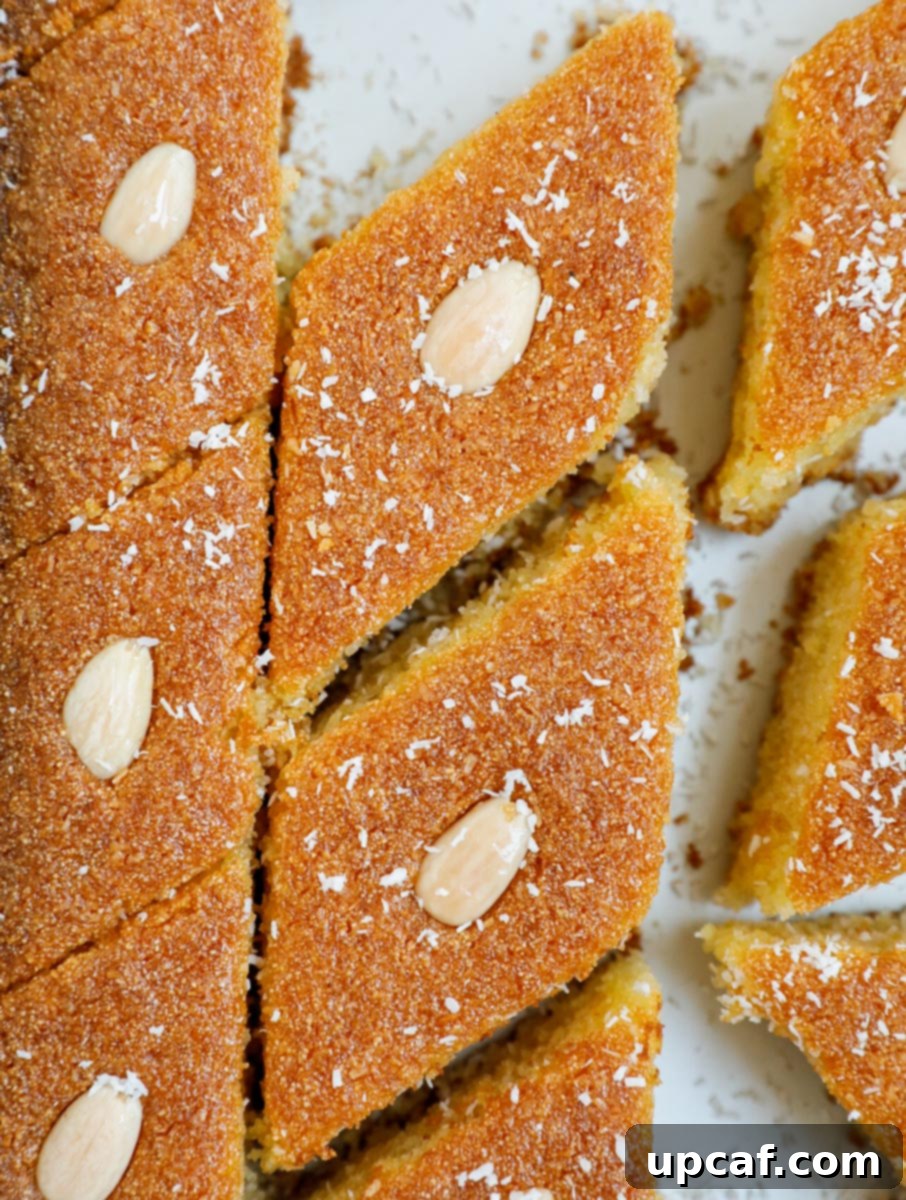
Imagine a dessert that is soft, incredibly moist, and bursting with a naturally sweet and subtly nutty flavor – that’s our semolina cake. It’s designed to be a delightful, bite-sized treat that captivates everyone who tries it. The beauty of this recipe lies in its simplicity; all ingredients come together with minimal effort before baking. The secret to its irresistible moisture and sweetness is a generous drenching of homemade simple syrup (Ater), which you can effortlessly prepare in advance, making your baking day even smoother.
If you choose to craft your simple syrup from scratch for this Basbousa recipe, you’ll likely find yourself with a bit extra. This is a wonderful opportunity to explore more delightful Lebanese desserts that perfectly complement the sweet, floral notes of the syrup. Our family favorites include the delicate Lebanese Shaabiyat Dessert, the creamy Lebanese Nights Dessert, and the beloved pancakes of Atayef. Each offers a unique taste of Middle Eastern patisserie, perfect for expanding your culinary repertoire.
What is Basbousa? The Beloved Middle Eastern Semolina Cake
Basbousa (pronounced bas-BOO-sah, and also known as Basbuusa or Basboosa) is a universally adored Middle Eastern dessert, synonymous with semolina cake. Its origins are often debated, with many food historians tracing its roots back to the Ottoman Empire, where a similar cake called Revani was (and still is) popular, particularly in Turkey. Regardless of its precise birthplace, the essence of Basbousa lies in its simple yet profound deliciousness: a tender cake made from semolina flour, baked until golden, and then generously drenched in a sweet, aromatic sugar syrup.
This sweet, often diamond-shaped, cake has countless regional variations, each with its own unique charm and name. For instance, in Lebanon, a very similar dessert is known as Namoura. While both share the same fundamental semolina base, the Basbousa (particularly the Egyptian version, which this recipe celebrates) distinguishes itself with the inclusion of shredded coconut in the batter, adding an extra layer of moisture, flavor, and textural delight. Other countries might adapt the recipe further, incorporating different nuts, flavorings, or toppings, but the core concept of a syrup-soaked semolina cake remains a staple in Middle Eastern households. Growing up, I had the pleasure of enjoying both the rich, coconut-infused Basbousa and the pure semolina goodness of Namoura, cementing their place as timeless comfort desserts.
Why You’ll Fall in Love with This Easy Semolina Cake
This Coconut Basbousa is more than just a dessert; it’s a delightful culinary experience that will quickly become a cherished favorite. Here’s why you’ll absolutely love making and sharing this authentic semolina cake:
- Unforgettable Flavor and Texture: Prepare for a sensory delight! This Basbousa is incredibly delicious, boasting a uniquely soft, moist, and tender crumb that practically melts in your mouth. The combination of semolina and shredded coconut creates a subtle nutty flavor beautifully complemented by the sweet, fragrant simple syrup. It’s no exaggeration to say that when I serve this, leftovers are a rare occurrence – it disappears in a flash!
- Remarkably Simple to Prepare: Who wants to wrestle with a complicated dessert, especially when you’re already managing a full dinner? This recipe is a dream for busy home cooks. From start to finish, the process is incredibly straightforward, primarily involving mixing ingredients and baking. It’s an ideal recipe for beginners, promising impressive results with minimal fuss, allowing you to create an authentic Middle Eastern treat from scratch with ease.
- The Ultimate Crowd-Pleaser for Any Occasion: This sweet, versatile cake pairs beautifully with virtually any meal or gathering. Whether you’re hosting a family dinner, celebrating a special occasion, enjoying an afternoon coffee, or simply craving something sweet, Basbousa fits the bill perfectly. Its comforting flavors and appealing diamond shape make it a universally loved dessert that will undoubtedly impress your guests and bring smiles to everyone’s faces.
- Authentic Middle Eastern Experience: Crafted with traditional ingredients and methods, this Basbousa offers a genuine taste of Middle Eastern hospitality and culinary heritage. It’s a wonderful way to explore diverse flavors and introduce a touch of exotic sweetness to your table.
- Economical and Accessible Ingredients: Most of the ingredients for Basbousa are readily available in any well-stocked pantry or local grocery store, making it an affordable and accessible dessert to whip up whenever the craving strikes.
Essential Ingredients for Your Perfect Basbousa Cake
Creating an authentic and delicious Basbousa cake relies on a specific set of ingredients, each playing a crucial role in achieving its signature flavor and texture. Here’s a detailed look at what you’ll need:

- Coarse and Fine Semolina: The star of the show! Semolina is made from durum wheat, which gives Basbousa its characteristic texture. We use a combination of coarse semolina (for structure and a delightful chew) and fine semolina, also known as farina or ferkha (for a tender crumb), to achieve the perfect balance. It’s essential for the authentic mouthfeel of the cake.
- Granulated Sugar: Sweetens both the cake batter and the all-important simple syrup. Its fine crystals dissolve beautifully, ensuring even sweetness throughout.
- Finely Shredded Coconut: This is what truly defines our Coconut Basbousa. Opt for unsweetened, finely shredded coconut. It adds incredible moisture, a delicate nutty flavor, and a lovely textural element without making the cake overly sweet.
- Baking Powder: A key leavening agent that helps the cake rise, contributing to its soft and fluffy texture.
- Baking Soda: Works in conjunction with the yogurt to provide additional lift and ensures an even, tender crumb by balancing the cake’s texture.
- Vegetable or Canola Oil: For this recipe, oil is preferred as it yields a lighter, more moist cake. You can, however, substitute with an equal amount of melted ghee (clarified butter) for a richer, more traditional flavor profile.
- Whole Fat Yogurt: An indispensable ingredient for moisture and a slight tang that beautifully complements the sweetness. Using whole fat yogurt ensures the richest flavor and the most tender texture.
- Orange Blossom Water: This aromatic floral water is a must for authentic Basbousa. It infuses the cake with a distinctive, delicate fragrance that elevates the entire dessert. Do not skip this for the true Middle Eastern experience!
- Sliced Almonds: Peeled and halved, these almonds are used to adorn the top of each piece, adding a beautiful presentation and a subtle crunch.
- Tahini Paste: Used for brushing the baking pan, tahini creates a non-stick surface and imparts a subtle, savory undertone that beautifully contrasts with the cake’s sweetness. It also helps achieve a perfectly golden-brown crust.
- Lebanese Simple Syrup (Ater): The transformative finishing touch! This cold sugar syrup is poured over the hot cake, ensuring it absorbs completely, making the Basbousa incredibly moist and sweet. You can find my detailed post here on how to prepare it ahead of time.
Step-by-Step Guide: How to Make Irresistible Coconut Basbousa Cake
Crafting this delightful Basbousa is a surprisingly simple process, yielding a dessert that tastes like it took hours. Follow these easy steps to achieve a perfectly moist and flavorful semolina cake:
- Prepare Your Oven: Begin by preheating your oven to 375°F (190°C). This ensures your oven is at the optimal temperature for even baking as soon as the batter is ready.
- Combine the Cake Batter Ingredients: In a large stand mixer bowl, add all the cake batter ingredients: both coarse and fine semolina, granulated sugar, finely shredded coconut, baking powder, baking soda, vegetable or canola oil, whole fat yogurt, and orange blossom water. Mix on a slow speed until all the ingredients are just well combined. Be careful not to overmix; overmixing can lead to a tough cake. The mixture should be thick and somewhat pasty.
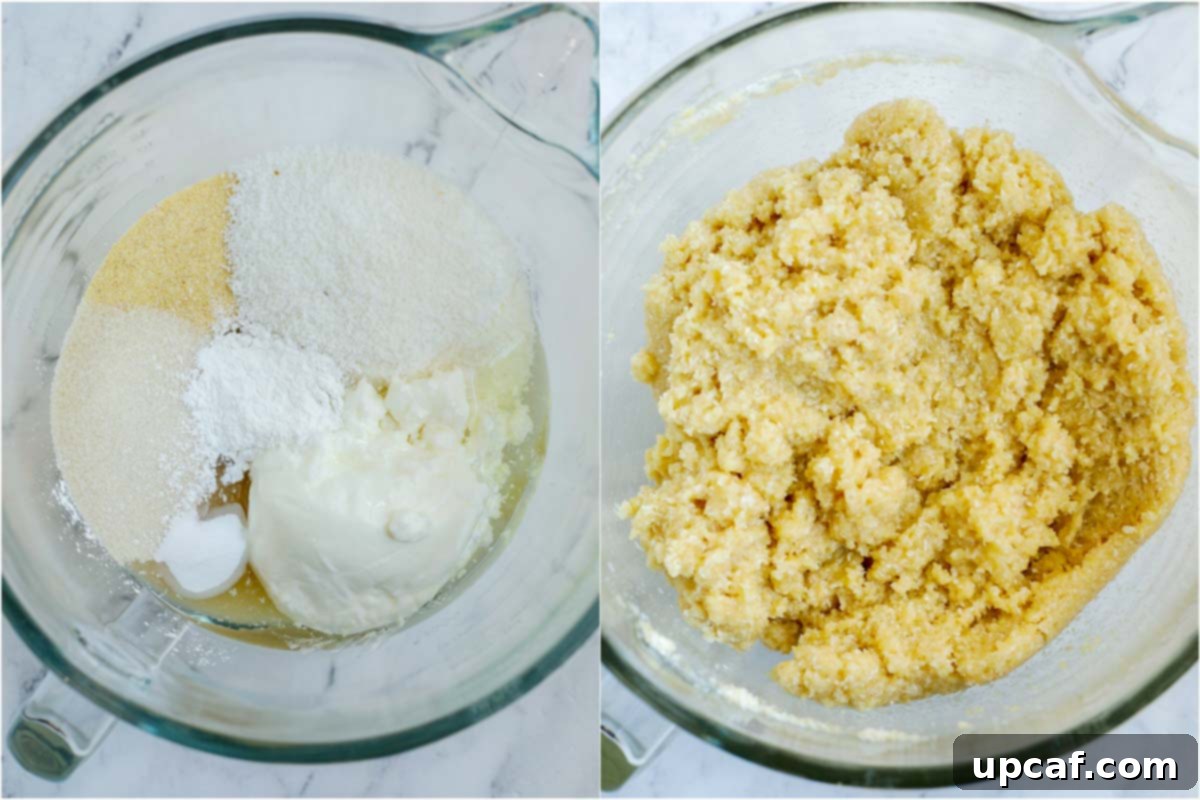
- Prepare the Baking Pan: Generously brush a non-stick 9 x 13 x 3 inch baking pan with tahini paste, ensuring both the bottom and sides are fully coated. Tahini not only prevents sticking but also adds a subtle nutty flavor and a beautiful golden crust to the edges of the cake.
- Pour and Rest the Batter: Evenly pour the semolina batter into the prepared pan. Use a spatula or the palm of your hand to spread the dough out smoothly and uniformly across the pan. Once spread, cover the pan and let the batter rest at room temperature for at least 30 minutes to an hour. This crucial step allows the semolina to fully absorb the moisture, resulting in a tender and perfectly textured cake.
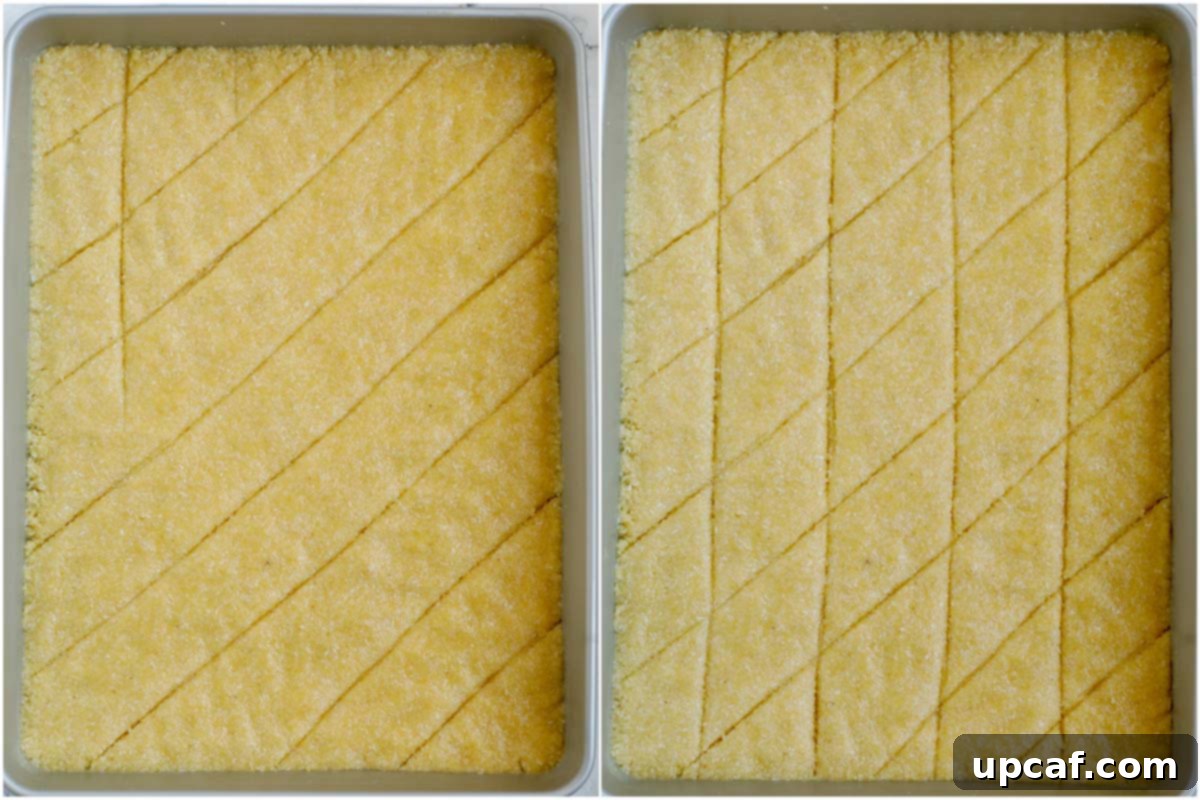
- Score and Decorate: Before baking, use a sharp knife to carefully cut the Basbousa into your desired shapes. Traditional choices are squares or diamonds, which are both aesthetically pleasing and easy to serve. Once cut, gently press a piece of half an almond onto the center of each individual cake piece. This adds an elegant touch and a delightful crunch.
- Bake to Golden Perfection: Place the pan in your preheated oven and bake for approximately 35 minutes, or until the Basbousa turns a beautiful golden brown color. If you desire a deeper golden hue on top, you can turn on the top broiler for just a couple of minutes towards the end of baking. Watch it very closely during this step to prevent burning.
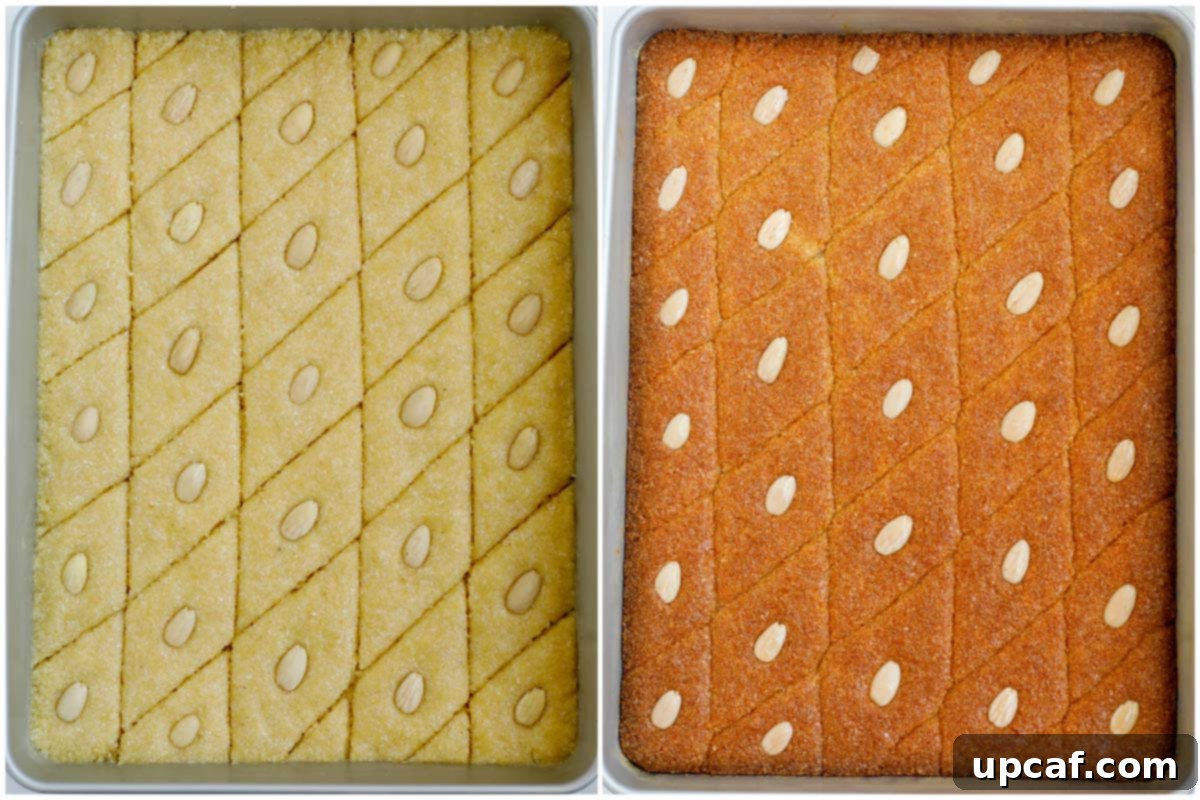
- Generously Add the Syrup: This step is critical for a moist Basbousa! Immediately after removing the hot cake from the oven, evenly pour the cold Lebanese simple syrup over the entire surface. The contrast in temperature allows the hot cake to eagerly absorb the cold syrup, ensuring every bite is rich with moisture and sweetness. A squeezable dispenser bottle can be helpful for an even distribution.
- Cool and Serve: Allow the cake to cool completely at room temperature before attempting to cut into it. This patience is key to achieving perfectly clean and beautiful slices. The cooling process can take approximately 3-4 hours, during which the cake continues to absorb the syrup and firm up. Just before serving, sprinkle a final touch of shredded coconut over the Basbousa for added flavor and visual appeal.
Expert Tips for Crafting Your Best Basbousa Cake
Achieving a truly exceptional Coconut Basbousa is simple with these expert tips that ensure moistness, perfect texture, and rich flavor:
- Don’t Skimp on the Syrup: The simple syrup is not merely a topping; it’s an integral part of the Basbousa’s character. The cake should be generously drenched in syrup immediately after baking. The hot cake will absorb all the cold syrup, becoming incredibly moist and tender. A lack of syrup will result in a dry, crumbly cake, so be generous!
- Pan Preparation is Key: While tahini paste is traditionally used for brushing the pan (and adds a lovely subtle flavor and golden crust), if you don’t have it, don’t worry. You can brush the pan with melted ghee (clarified butter) for richness or use a baking spray and lightly dust with flour to prevent sticking.
- Nut Topping Variations: Sliced almonds are classic and beautiful, but feel free to experiment! Pistachios or pine nuts make excellent alternatives, offering different textures and flavors. While I personally prefer almonds, choose what you love.
- The Hot Cake, Cold Syrup Rule: This is a golden rule for perfect Basbousa. Pouring cold syrup over a hot cake ensures maximum absorption, which is vital for that signature moist, tender crumb. Do not skip this step or pour warm syrup on warm cake, as it will not absorb as effectively.
- Pre-Cutting for Perfect Portions: Scoring the Basbousa into squares or diamonds before baking is not just for aesthetics; it helps immensely with clean, beautiful cuts after the cake is baked and cooled. It also allows the syrup to penetrate more deeply and evenly into each piece.
- Patience During Resting and Cooling: Allowing the batter to rest for an hour before baking lets the semolina fully hydrate, leading to a much tenderer cake. Similarly, cooling the cake completely (3-4 hours) after pouring the syrup is crucial for the cake to set properly and absorb the syrup fully, ensuring firm, neat slices.
- Avoid Overmixing the Batter: Mix the ingredients just until combined. Overmixing can develop the gluten in the semolina, resulting in a tougher, less tender cake.
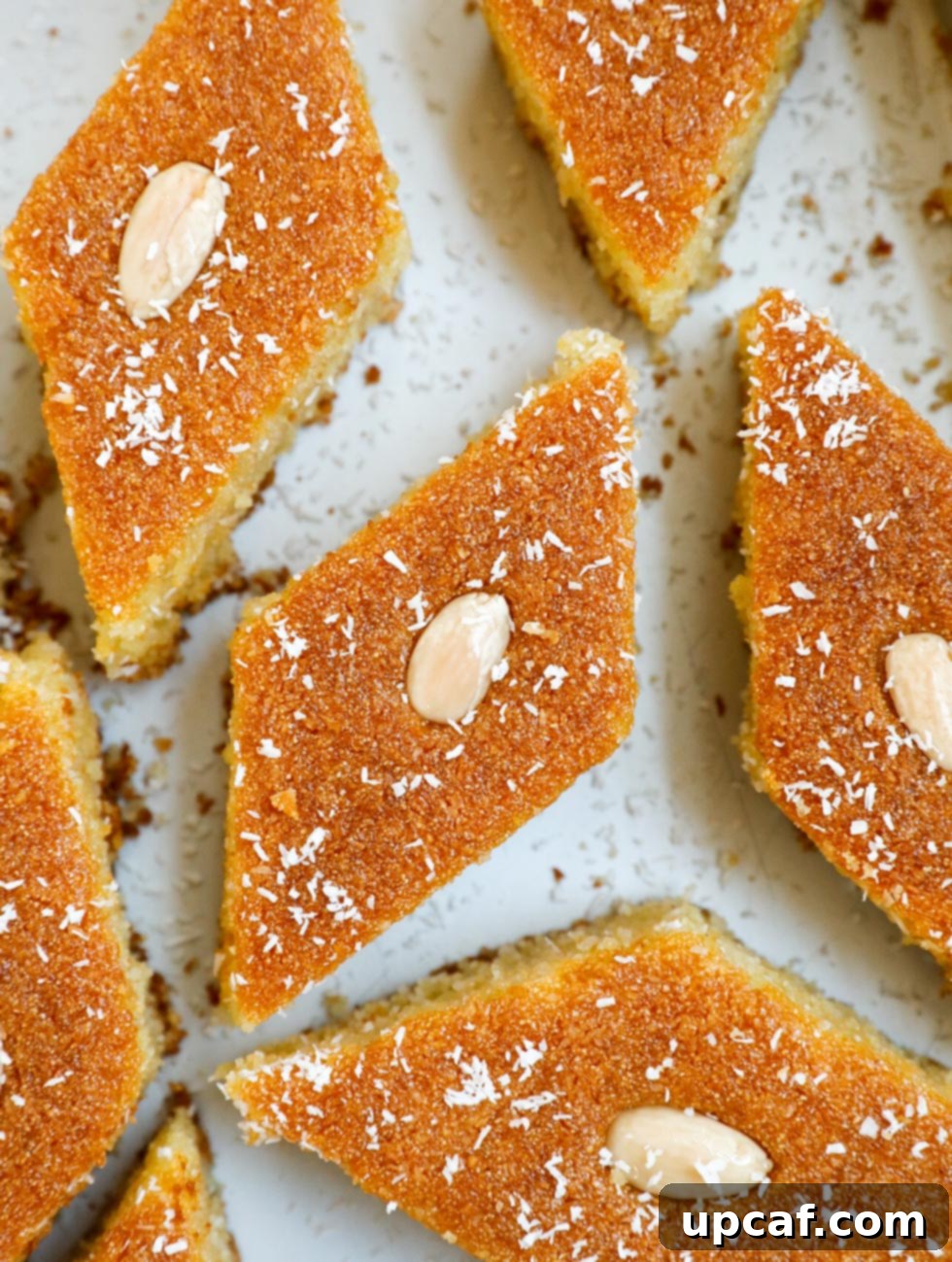
Frequently Asked Questions About Coconut Basbousa
Basbousa is incredibly versatile and can be served either chilled or at room temperature, depending on your personal preference. Many enjoy its cool, refreshing quality when served chilled, while others prefer the softer texture and more pronounced aromas at room temperature. If you find that refrigeration has made it a bit firm, simply let a slice sit out at room temperature for a little while before eating to restore its tender softness.
To maintain its freshness and moisture, store Basbousa in an airtight container. It will keep beautifully at room temperature for up to 5 days. For a longer shelf life, you can refrigerate it, where it will remain at its best for about 7-10 days. Just remember to allow refrigerated pieces to thaw slightly at room temperature to soften before enjoying.
Semolina is a coarse, purified wheat middling’s of durum wheat. It’s distinct from regular all-purpose flour due to its texture and the specific type of wheat it comes from. Semolina is widely used in various culinary applications, most notably in making traditional pastas, couscous, and a variety of sweet puddings and cakes like Basbousa. It’s important to note that because it’s derived from wheat, semolina is not gluten-free.
Basbousa and Namoura are indeed very similar and often confused, but they have a key distinction. “Basbousa” is the common term used in Egypt (and broadly in the Middle East) for this semolina cake, while “Namoura” is the term used in Lebanon. Both share the same base ingredients and are essentially semolina cakes soaked in syrup. However, the primary difference lies in the Basbousa (Egyptian version) typically includes shredded coconut in its batter, which Namoura does not. This coconut addition gives Basbousa its unique flavor and texture profile.
Absolutely! Basbousa is an excellent make-ahead dessert. It actually benefits from resting for a few hours (or even overnight) after the syrup is added, as this allows the flavors to meld beautifully and the cake to become even more moist. Simply prepare it the day before your event, cover it tightly, and store it at room temperature or in the refrigerator until ready to serve.
While orange blossom water is highly recommended for its authentic Middle Eastern aroma, if you can’t find it, you can substitute it with an equal amount of rose water for a different floral note, or a teaspoon of vanilla extract for a more universal flavor. However, for the true Basbousa experience, it’s worth seeking out orange blossom water!
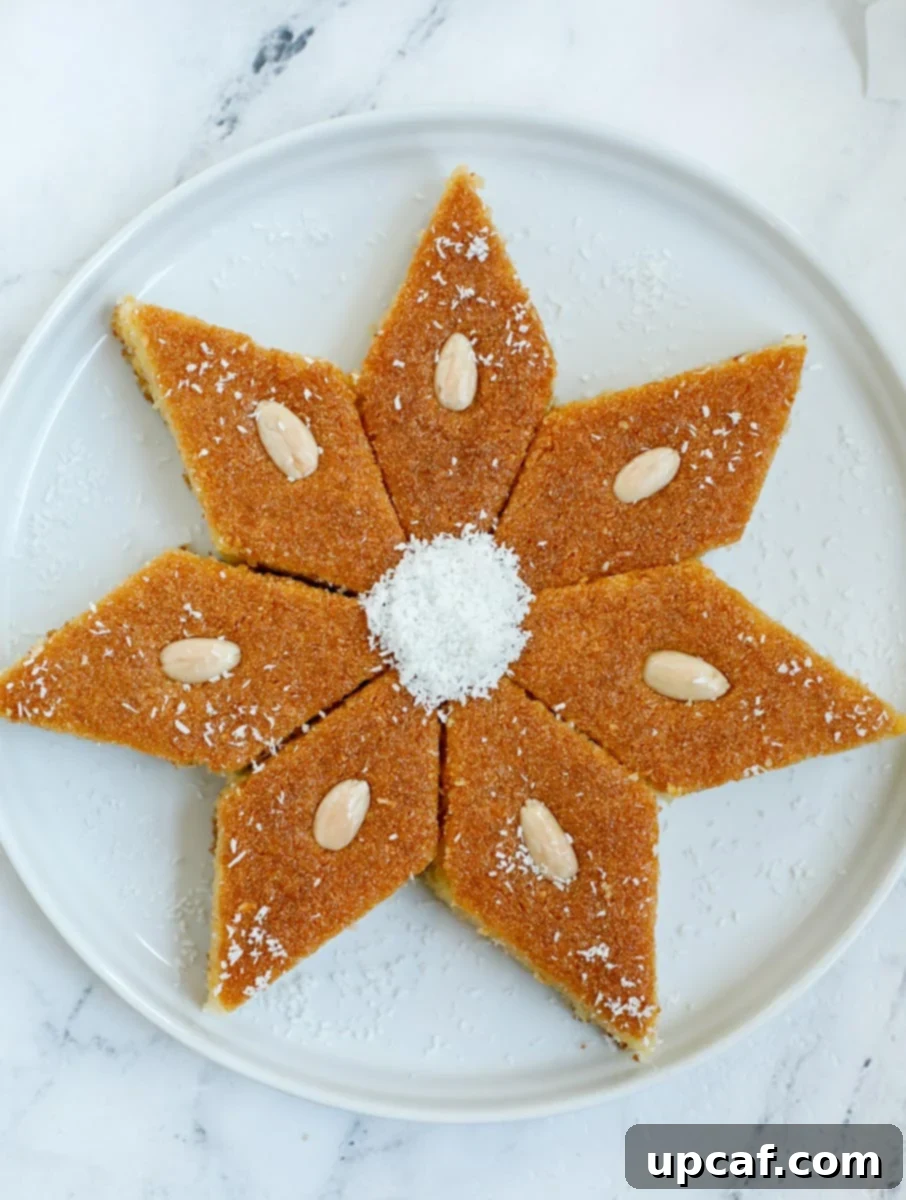
Explore More Authentic Lebanese Recipes
If you’ve enjoyed the taste of this Coconut Basbousa, you’ll love diving deeper into the rich and diverse world of Lebanese cuisine. Here are some more beloved recipes from our kitchen that we encourage you to try:
- Lebanese Spinach Pies (Fatayer Bi Sabanekh)
- Hearty Lebanese Chicken Lentil Soup
- Easy Kafta and Potato Stew
- Creamy Baba Ghanoush
- Flavorful Manakeesh Zaatar
- Classic Kibbeh Bil Sanieh (Baked Kibbeh)
We truly hope you find immense joy in exploring all the recipes shared here, especially this authentic and delightful Coconut Basbousa. It’s a dessert that embodies tradition, flavor, and simplicity, perfect for any occasion. Please take a moment to try it, savor every bite, and share your experience with us by leaving a star rating and a comment below. Your feedback means the world to us!
For more delicious recipes and culinary inspiration, be sure to follow Cookin’ With Mima on FACEBOOK |INSTAGRAM |PINTEREST to stay updated on all our latest posts and recipes. Happy cooking!
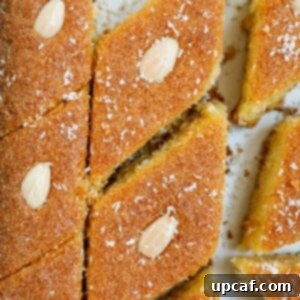
Pin
Basbousa Cake with Coconut
Ingredients
Cake Batter
- 2 ¾ cups coarse semolina
- ½ cup fine semolina, also known as ferkha
- 1½ cup granulated sugar
- 2 cups finely shredded coconut, unsweetened
- 3 tsps. baking powder
- 1½ tsp. baking soda
- ¾ cup vegetable or canola oil
- 1½ cup yogurt, whole fat
- ¼ cup orange blossoms water
Everything else
- ⅓ cup sliced almonds, peeled, halves
- 3 tbsps. tahini paste, for brushing the pan
- 3 cups Cold Lebanese Simple Syrup, Or more per preference
Instructions
- Preheat oven to 375 F.
- Mix all cake batter the ingredients in a stand mixer bowl on slow speed until well combined.
- Brush a non stick 9 x 13 x 3 inch pan with tahini paste (both bottom and sides). Pour in the batter and spread the dough out with a spatula or your palm to even is out. Cover and let the batter rest for 30 minutes to absorb all the moisture.
- Cut out the Basbousa into whatever shape you want. Squares and Diamonds are best. Place a piece of half an almond on top of each piece.
- Bake in the oven for about 35 minutes or until golden brown in color. You can turn on the top broiler for a couple of minutes before removing it from the oven to add a more deeper brown color to the top if needed. Watch closely if you do that.
- Right when you remove from the cake from the oven, evenly pour out the sugar syrup onto the cake. I like using a squeezable dispenser bottle to do that.
- Let the cake completely cool at room temperature before cutting through to get a perfect cut. It should take about 3-4 hours. Sprinkle some shredded coconut on the Basbousa before serving.
Notes
- The cake should have a generous amount of syrup so it doesn’t come out dry. The cake will absorb all the syrup.
- If you don’t have tahini, you can brush the pan with ghee or spray with baking spray and dust with flour.
- If you don’t have almonds, you can place pistachios or pine nuts on top of the Basbousa instead. But I prefer almonds.
- Do not skip the syrup. When the cake is still hot and the syrup is poured on, the cake absorbs it and helps it become extra moist.
- Pre-cutting the Basbousa before baking helps make it much easier to make clean beautiful cuts after it’s been baked.
Nutrition
Like this recipe? Rate and comment below!
